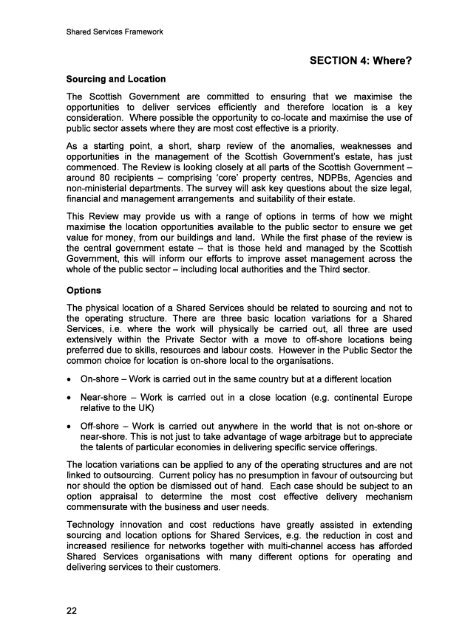Shared Services - Guidance Framework - Scottish Government
Shared Services - Guidance Framework - Scottish Government
Shared Services - Guidance Framework - Scottish Government
Create successful ePaper yourself
Turn your PDF publications into a flip-book with our unique Google optimized e-Paper software.
<strong>Shared</strong> <strong>Services</strong> <strong>Framework</strong><br />
Sourcing and Location<br />
SECTION 4: Where?<br />
The <strong>Scottish</strong> <strong>Government</strong> are committed to ensuring that we maXlmlse the<br />
opportunities to deliver services efficiently and therefore location is a key<br />
consideration. Where possible the opportunity to co-locate and maximise the use of<br />
public sector assets where they are most cost effective is a priority.<br />
As a starting point, a short, sharp review of the anomalies, weaknesses and<br />
opportunities in the management of the <strong>Scottish</strong> <strong>Government</strong>'s estate, has just<br />
commenced. The Review is looking closely at all parts of the <strong>Scottish</strong> <strong>Government</strong>around<br />
80 recipients - comprising 'core' property centres, NDPBs, Agencies and<br />
non-ministerial departments. The survey will ask key questions about the size legal,<br />
financial and management arrangements and suitability of their estate.<br />
This Review may provide us with a range of options in terms of how we might<br />
maximise the location opportunities available to the public sector to ensure we get<br />
value for money, from our buildings and land. While the first phase of the review is<br />
the central government estate - that is those held and managed by the <strong>Scottish</strong><br />
<strong>Government</strong>, this will inform our efforts to improve asset management across the<br />
whole of the public sector - including local authorities and the Thi"rdsector.<br />
Options<br />
The physical location of a <strong>Shared</strong> <strong>Services</strong> should be related to sourcing and not to<br />
the operating structure. There are three basic location variations for a <strong>Shared</strong><br />
<strong>Services</strong>, i.e. where the work will physically be carried out, all three are used<br />
extensively within the Private Sector with a move to off-shore locations being<br />
preferred due to skills, resources and labour costs. However in the Public Sector the<br />
common choice for location is on-shore local to the organisations.<br />
• On-shore - Work is carried out in the same country but at a different location<br />
• Near-shore - Work is carried out in a close location (e.g. continental Europe<br />
relative to the UK)<br />
• Off-shore - Work is carried out anywhere in the world that is not on-shore or<br />
near-shore. This is not just to take advantage of wage arbitrage but to appreciate<br />
the talents of particular economies in delivering specific service offerings.<br />
The location variations can be applied to any of the operating structures and are not<br />
linked to outsourcing. Current policy has no presumption in favour of outsourcing but<br />
nor should the option be dismissed out of hand. Each case should be subject to an<br />
option appraisal to determine the most cost effective delivery mechanism<br />
commensurate with the business and user needs.<br />
Technology innovation and cost reductions have greatly assisted in extending<br />
sourcing and location options for <strong>Shared</strong> <strong>Services</strong>, e.g. the reduction in cost and<br />
increased resilience for networks together with multi-channel access has afforded<br />
<strong>Shared</strong> <strong>Services</strong> organisations with many different options for operating and<br />
delivering services to their customers.<br />
22

















